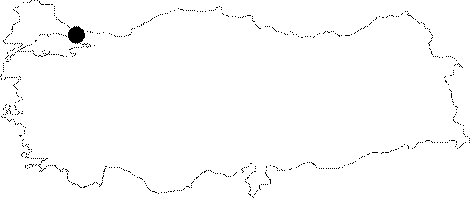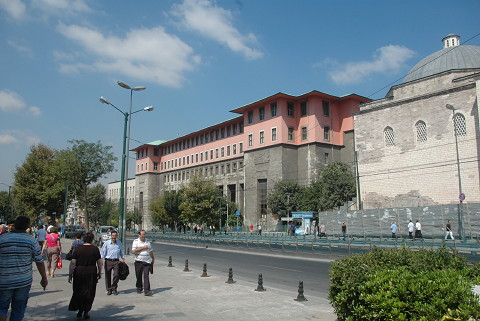| Location: The building complex situated adjacent to each other didn't survive to the present day. It was close to the intersection of the modern Ordu and Resit Pasa Streets within the borders of the Beyazit Campus of the Istanbul University in the Beyazit Neighbourhood of the Eminönü District in Istanbul. At present, the complex has been obscured by the building of the Science and Literature Department of the Istanbul University. |
| Geography and Environment: Around 80 m south of the building complex, which was near the Forum of Theodosius, stretched the Mese Street, and 150 m to the southeast stood the Triumphal Arch of Theodosius from the Late Roman/Early Byzantine Period, and 200 m to the northwest was the Church D of Beyazit. |
| Research and Excavation: The building complex, which was accidentally unearthed during the excavation activities of the building for the Science and Literature Faculty in the campus of the Istanbul University, and called as the Churches A, B and C of Beyazit by the researchers, was surveyed by N. Firatli [Mathews 1976]. The remains were cleared away after partial analyses and surveys. |
| Description: Building Phases: Other than the Church A, which was erected during the 6th century, the original construction dates of other two sanctuaries from a later period are uncertain [Mathews 1976]. Architectural Features: Church A: It is a basilica with three naves, and the central nave measures 24x8.4 m while the lateral ones are 15.4x4.2 m in dimension. There were open courtyards flanking the sanctuary. In the southern courtyard, there was a structure in the form of a small square, probably a martyrium, and under the northern courtyard, there was a cistern with two sections. The land, which was slightly elevated toward the east to the Theodosius Forum, formed a narrow courtyard in front of the church together with a retaining wall including niches [Firatli 1951:164-167, pic. 1, pl. 1a; Müller-Wiener 2001:pic. 51]. The church A was dated to the first half of the 6th century (Müller-Wiener 2001). Church B: Being 1.5 m higher than the other two churches, probably it was a domed building with three naves and a synthronon. The middle nave was 13 m long, and 4.4 m wide while the lateral nave to the north was 3.6 m, and the one to the south was 2.1 m long. To the north was a cistern adjacent to the sanctuary [Firatli 1951: 167-168, pic. 1, pl. 1b-1c, 2]. Church C: The Church C, smaller than the other two sanctuaries, was probably erected after the Church A, but before the Church B. The central nave of the three-naved sanctuary measured 11.5x4.5 m, and the lateral ones were 9.5x2.3 m [Firatli 1951:168-171, pic. 1; Müller-Wiener 2001: pic. 50; Mathews 1976:28-29]. |
| Finds: In the vicinity of the building complex, some graves from the 2nd century were unearthed [Müller-Wiener 2001]. The excavation yielded capitals from the Justinian Period, similar to the ones in the lateral naves of the Museum of St. Sophia [Firatli 1951:175-176, pl. 3-4]. Also found are various architectural plastic elements [Firatli 1951:176-177, pl. 5, 6d-6e] and the only ambon unearthed in Istanbul up until today. The two-step ambon made of red ribbed marble has been currently exhibited in the garden of the Museum of St. Sophia [Firatli 1951:178, pl. 6a-6c; Mathews 1976:28-29, pic. 5.1-5.11]. |
| Interpretation: W. Müller-Wiener indicates that a part of the construction material of the Church B, known to have been erected at a later period, might have been gathered from the Church A [Müller-Wiener 2001]. Although N. Firatli claimed that the Church A belonged to the 4th century, and the Church C to the 6th century, this claim didn't find acceptance by other scientists [Mathews 1976]. A.M. Schneider proposes that the Church C, in fact, might have been a refectory. And, T.F. Mathews indicates that the plan of the Church B resembles a piscina [Mathews 1976]. |
| Destruction: The remains did not survive to date due to destruction by housing and road construction [TAYEx 20.08.2008]. |


